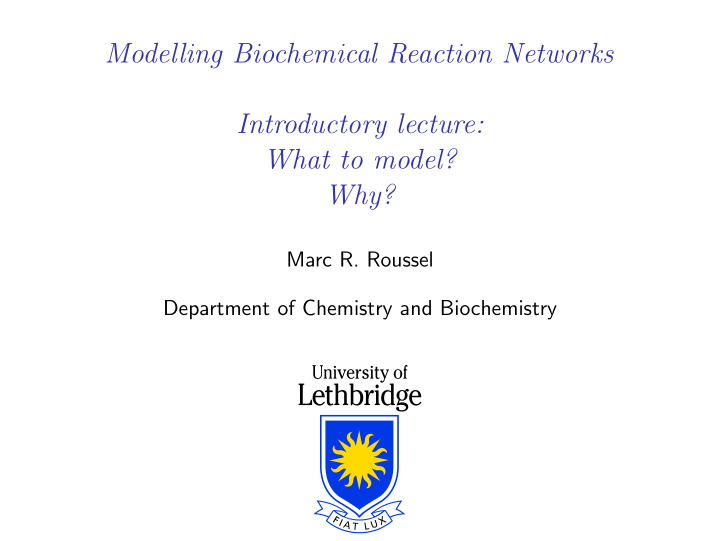



Modelling Biochemical Reaction Networks Introductory lecture: What to model? Why? Marc R. Roussel Department of Chemistry and Biochemistry
Recommended reading ◮ Fall, Marland, Wagner and Tyson, chapter 1
A bit of philosophical background Popper: Falsification of hypotheses drives science forward.
Modelling as machinery for the falsification of mechanistic hypotheses ◮ We start with some observations we are trying to explain. ◮ Someone generates a hypothesis for a mechanism for the phenomenon. ◮ Mechanistic hypotheses can be converted to mathematical models. ◮ Does the model replicate the observations that the hypothesis was meant to explain? ◮ Does the model make any new predictions that could be tested experimentally?
Other reasons to make mathematical models Discrimination between rival models Exploration of phenomena not readily studied experimentally ◮ Exploration of parameter space Reduction of a phenomenon to its essentials for further study (Re)engineering of a process Exploration of possible interventions
Biochemistry as a multiscale discipline ◮ Biochemical processes depend on and affect phenomena over a wide range of spatial and temporal scales ◮ Some relevant length scales: Chemical bonds: 10 − 10 m Macromolecular dimensions: 10 − 9 –10 − 8 m Length of a bacterium or of a mitochondrion: 10 − 6 m Red blood cell diameter: 10 − 5 m Neuron length: 10 − 3 –1 m ◮ Some relevant time scales: Time for Na + to transit through a channel: 10 − 8 s Macromolecular conformational changes: 10 − 7 –10 − 3 s Transcription, translation: 10 1 –10 4 s Circadian rhythm: 10 5 s
Number of molecules ◮ Suppose that [X] = 10 µ mol / L . ◮ How many molecules of X do we have? V /L Example N X 10 − 16 Axon terminal 600 10 − 15 Bacterium 6000 10 − 14 Yeast cell 60 000 10 − 12 6 × 10 6 Mammalian cell
Modelling biochemical systems ◮ You can’t model everything completely. ◮ Many choices to make: ◮ Is a qualitative model OK or do you want quantitative agreement? ◮ Which physical part of the system (subcellular compartment, cell, group of cells, etc.) do you want to model? ◮ Do you need to take the spatial dimension into account explicitly? ◮ Do you need to explicitly model diffusive transport? ◮ Is it OK to just treat the system as a set of coupled compartments? ◮ What range of time scales do you need to cover? ◮ What biochemical processes do you need to include? At what level of detail? ◮ Number of molecules: continuous description (many molecules) or stochastic (statistical; few molecules)?
Level of biochemical detail P i P i P i P i
This course ◮ Focus on kinetics ◮ Both differential equation (continuous) and stochastic models covered ◮ Compartmental descriptions of spatial effects only ◮ Emphasis on selecting the particular interactions to model, and the level of description required
Some central questions (some of which may not be resolved in this course) ◮ How do you decide if you have a “good” model? ◮ Past a certain level of complexity, we tend to rely heavily on computation. How do we know if the results of a computation are correct? ◮ Since kinetic parameters are often difficult to get, is it OK just to get the right structure for a model?
Recommend
More recommend